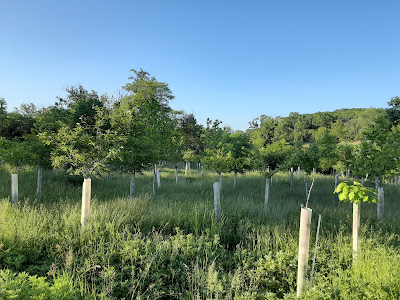I like trees. I've written about my despair when they are cut down, including by me. But after a recent walk I had to wonder about the unintended consequences of planting some trees in a particular area.
 |
| Saplings, May 2023 (Margo D. Beller) |
In the Central Park of Morris County not far from me a field was planted with tree saplings a number of years ago. All you could see were rows of protective tubing. In autumn 2021 I went for a walk in that area after a long absence and noticed the saplings had grown tall enough to be seen above the tubing.
The other week I went back and the saplings were even taller. I could now identify many of the trees including tulip poplars, maples, even at least one sweetgum. What happens when they all grow up, I wondered. Tulip poplars alone can grow 70 to 90 feet tall and have a 35- to 50-foot spread. It is also a fast-growing hardwood tree, which might explain why it was planted here.
 |
| Saplings, November 2021 (Margo D. Beller) |
I can't remember exactly when Morris County put in the saplings. It could've been after hurricane Sandy blew through in 2012 and toppled trees in this field, once part of a working farm associated with the old Greystone hospital. The saplings could've been planted as part of the work the county did when it took over the land to turn it into a multi-use park.
 |
| The field in the aftermath of Hurricane Sandy in 2012, which might be the reason more trees were planted. (Margo D. Beller) |
During that time, the old hospital buildings including the wards, the farm and the Kirkbride administration building came down. Old or damaged trees came down with them. (Many other trees that came down in a different area were neither sick nor damaged. They were in the way of a very large planned soccer field.)
This old farm field usually draws a lot of birds depending on the season. In past years I've found different types of sparrows, warblers, vireos and thrushes. But now I have to wonder what will happen when the trees grow to their full height. The area is already changing. The grasses around the saplings have not been cut and have become very long and weedy. This is good for some birds but not for others.
Once the trees have grown and darken the area it will change even more. Will there be more forest dwellers? Bird that look for insects or build nests in treetops? I fear the sparrows and other grassland birds that prefer wood edges to deep woods will go elsewhere.
I'll just have to see what happens when those trees throw shade.
